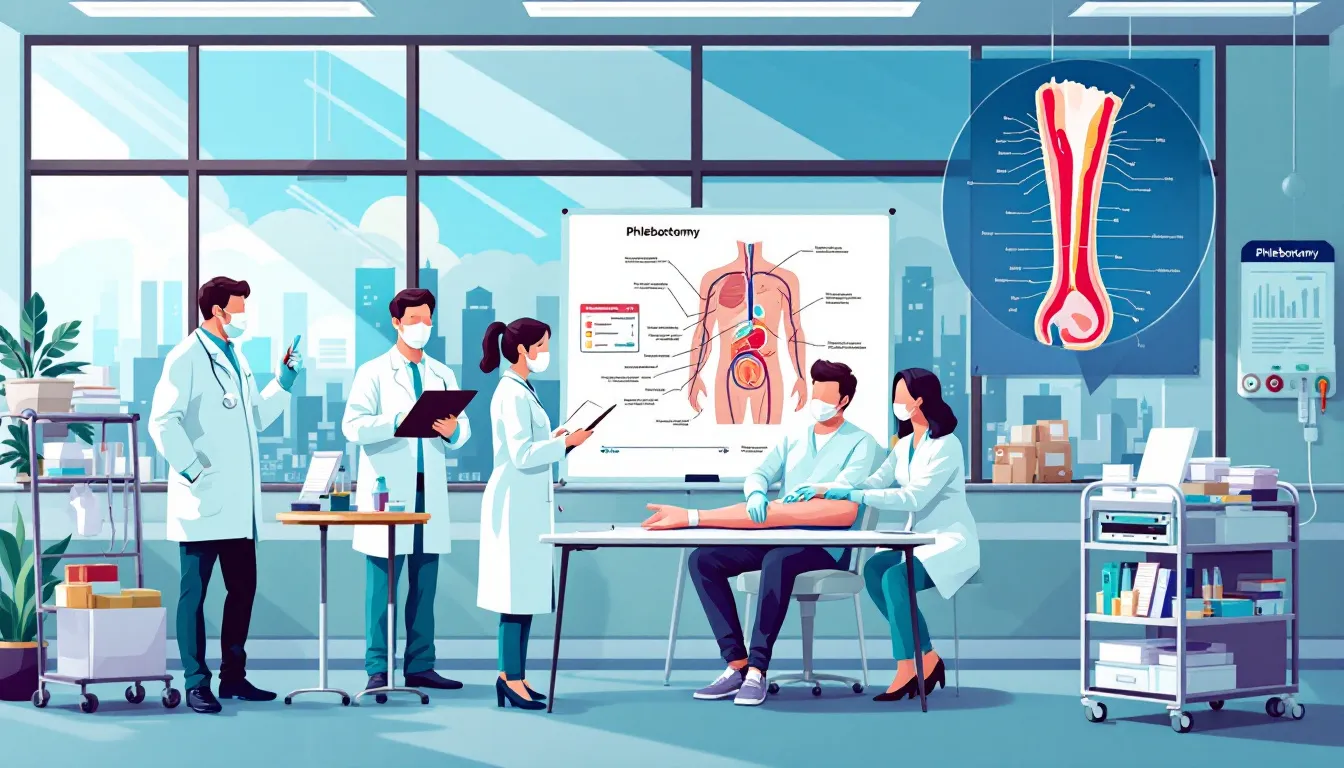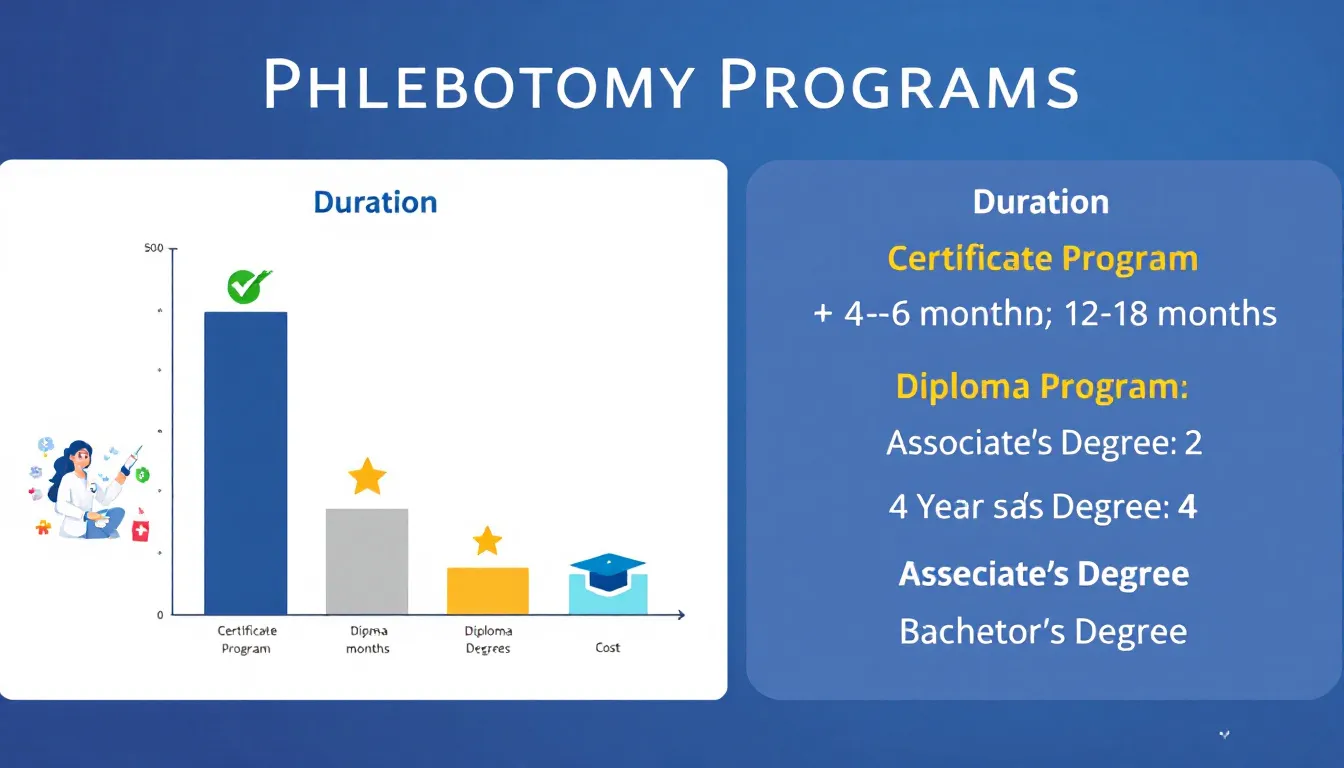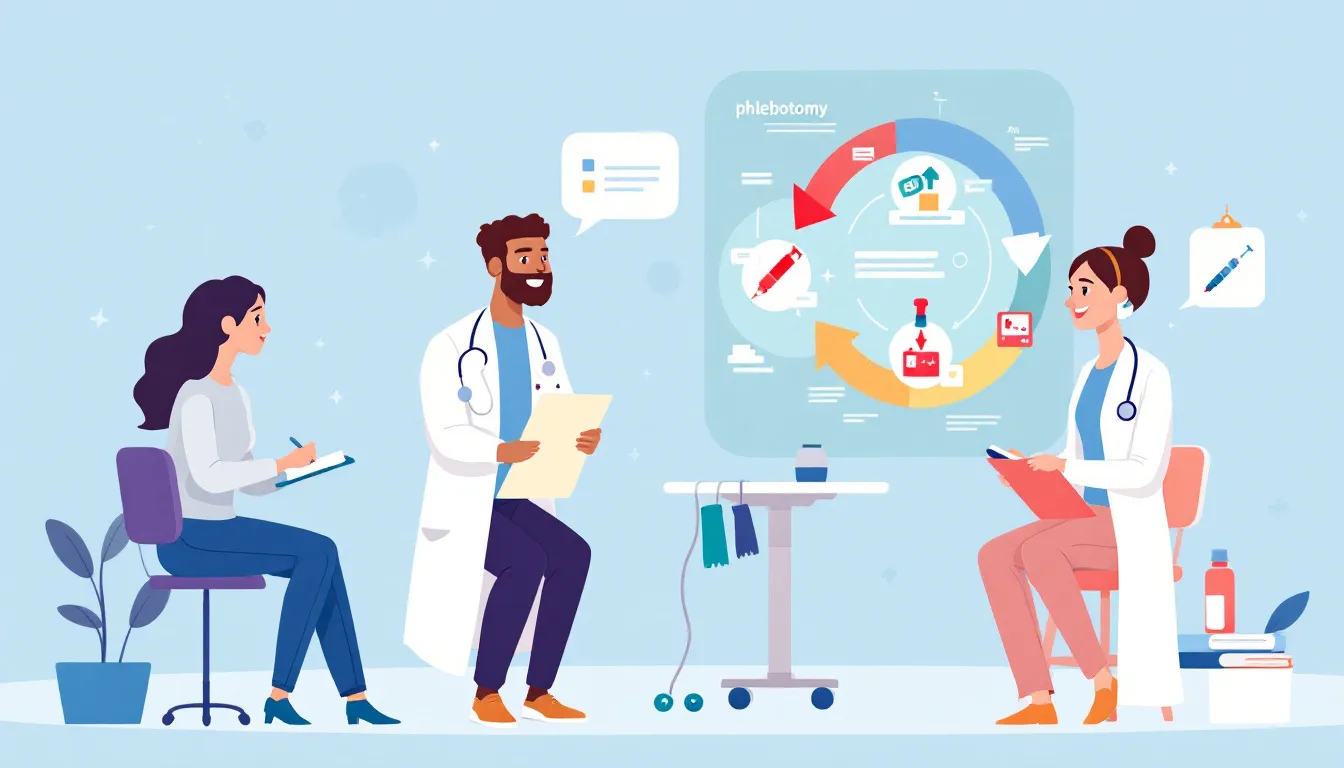Top Training for Phlebotomist: Essential Skills & Certification Options
To become a phlebotomist, you need to complete specific training for phlebotomist that covers both theoretical knowledge and practical skills. In this article, we’ll break down the essential components of phlebotomist training, admission requirements, program lengths, and what to expect in terms of career prospects. By understanding these key elements, you can make informed decisions about your phlebotomy career path.
Key Takeaways
- Phlebotomy technician training combines theoretical learning with practical experience, covering essential topics like infection prevention and anatomical understanding.
- Admission to phlebotomy programs typically requires a high school diploma, background checks, and documentation of immunizations, with no prior healthcare experience needed for many online courses.
- Certification significantly enhances a phlebotomist’s employability, and successful technicians must possess key skills such as dexterity, attention to detail, and strong communication abilities.
Understanding Phlebotomy Technician Training

Phlebotomy technician training involves a unique blend of theoretical learning and practical training. This dual approach ensures that students are well-prepared for real-world applications, blending classroom instruction with hands-on experiences to prepare students for their careers. The curriculum is designed to cover essential aspects such as proper phlebotomy technique, specimen processing, communication, and a foundational understanding of anatomy and physiology.
The training programs typically include courses on medical terminology, infection prevention practices, and legal healthcare issues. This comprehensive education is crucial for preparing students to handle the responsibilities of drawing blood and processing specimens accurately and safely.
Upon completing the training, students possess the expertise necessary to thrive as phlebotomy technicians.
Admission Requirements for Phlebotomy Programs
Aspiring phlebotomy technicians must meet several admission requirements to begin their training. The first crucial step is obtaining a high school diploma or equivalent GED. This foundational education ensures students possess the basic knowledge needed for the program. Some programs may also require candidates to pass an entrance exam to assess their readiness for the coursework.
Applicants must also pass a criminal background check and may need to complete a urine drug screening, ensuring the safety and integrity of the healthcare environment. All required documentation, including proof of immunizations and a tuberculosis test, must be submitted with the application to be considered complete.
Interestingly, no prior work experience is required for enrolling in many online phlebotomy technician courses. This opens opportunities for individuals new to the healthcare field to pursue this career. However, securing national certification in phlebotomy typically requires a high school diploma and the completion of a phlebotomy program or one year of experience in the field.
Meeting these admission requirements is the initial step toward becoming a certified phlebotomist. This process prepares students to meet the necessary standards for providing high-quality patient care, enabling them to confidently pursue their training and career in healthcare.
Components of Phlebotomy Training Programs
Phlebotomy training programs are structured to provide a comprehensive education that blends classroom learning, hands-on training, and a strong focus on quality assurance and safety protocols. This multi-faceted approach ensures that phlebotomy technicians are well-equipped to handle the demands of their roles in various healthcare settings.
Classroom Learning
Classroom learning plays a crucial role in phlebotomy technician training. Students study subjects like human anatomy, medical terminology, and infection prevention practices, forming a solid theoretical foundation for understanding blood collection and patient care complexities. For instance, infection control procedures are critical to ensuring the safety of both patients and technicians during blood draws.
Quizzes, case studies, and assignments reinforce the learning material. Programs like Northeast Medical Institute’s 80-hour course blend theoretical knowledge with practical skills, preparing students for a healthcare career, to pass certification exams and excel in real-world healthcare settings.
Hands-On Training
Hands-on training allows students to apply their theoretical knowledge. This aspect emphasizes skills such as drawing blood, handling specimens, and patient interaction. Mastery of venipuncture, the process of puncturing a vein to collect blood, is critical. Students typically perform at least 100 venipunctures in an outpatient setting to gain essential experience.
This component also covers safe blood collection techniques and proper specimen labeling to prevent lab errors. In-person lab sessions allow students to refine their practical skills and troubleshoot vein location challenges, ensuring they are well-prepared for their roles.
Quality Assurance and Safety Protocols
Quality assurance and safety protocols play a vital role in phlebotomy training programs. These practices protect both patients and technicians, ensuring safe and hygienic blood collection. Students learn the importance of strict hygiene practices, tool sterility, and adherence to standardized procedures.
Quality assurance also involves understanding and implementing safety protocols to minimize risks during blood collection. Adherence to these protocols ensures the accuracy of work and patient safety, maintaining high standards in healthcare.
Choosing a Phlebotomy Technician Program
Choosing the right phlebotomy technician program is a critical step toward a successful healthcare career. When evaluating programs, several key factors should guide your decision:
- Accreditation: Ensure the program is accredited by reputable organizations such as the National Accrediting Agency for Clinical Laboratory Sciences (NAACLS) or the American Society for Clinical Pathology (ASCP). Accreditation guarantees that the program meets high educational standards, which is crucial for your future career.
- Curriculum: A comprehensive curriculum is essential. Look for programs that cover vital topics, including medical terminology, blood collection techniques, and patient communication. These subjects form the foundation of your training and prepare you for real-world scenarios.
- Clinical Experience: Hands-on training is indispensable in phlebotomy. Opt for programs that offer extensive clinical experience in diverse settings like hospitals, clinics, and laboratories. This practical exposure is crucial for mastering blood draws and other essential skills.
- Certification Preparation: Choose a program that prepares students for a certification exam, such as the Certified Phlebotomy Technician (CPT) or the Registered Phlebotomy Technician (RPT). Certification not only enhances your employability but also validates your competence in the field.
- Job Placement and Career Services: Consider programs that provide robust job placement assistance and career services. These services can include resume building, interview preparation, and job placement assistance, which are invaluable as you transition from training to employment.
By carefully considering these factors, you can select a phlebotomy technician program that aligns with your career goals and sets you up for success.
Online and On-Campus Programs
Phlebotomy technician programs are available in both online and on-campus formats, each offering unique advantages and potential drawbacks. Understanding these can help you choose the best fit for your lifestyle and learning preferences.
Certification Exam Preparation
Certification exam preparation is a crucial part of phlebotomy technician training. Programs equip students with the knowledge and skills needed to pass the exam, including reviewing key concepts, practicing procedures, and understanding the exam format. Some national certification exams are available online, offering flexibility.
Certification exams are typically an expense students must cover, but the investment is worthwhile. Certification significantly enhances employability and career prospects, validating the technician’s competence and readiness for their role.
Accreditation and Certification
Accreditation and certification are pivotal in the field of phlebotomy, ensuring that you receive quality education and are recognized as a competent professional.
Duration and Cost of Phlebotomy Programs

Phlebotomy training programs vary in duration and cost based on the institution and program comprehensiveness. Accelerated courses last four to eight weeks, while standard programs range from four to six months. Tuition costs range from $1200 to $3,000, plus additional fees for materials and certification.
Many schools provide financial aid options, scholarships, and payment plans to help manage training costs.
Program Length
Phlebotomy program lengths vary widely. Intensive options can be completed in a few weeks, while community college programs may last one to six months. Many programs are designed to be completed within eight to twelve weeks, balancing comprehensive training with a short time commitment.
Accelerated programs can be completed in as little as one month. Online training ranges from four weeks to six months, offering flexibility for varying schedules. Understanding program durations helps prospective students choose the best fit for their needs and career goals.
Tuition and Financial Aid Options
Tuition for phlebotomy programs ranges from $1,000 to $3,000, depending on the institution and program comprehensiveness. Students should also budget for additional expenses like uniforms, lab fees, and certification exam fees, which can add several hundred dollars to the total cost.
Financial aid options are available to help manage these costs. Federal Pell Grants and student loans offer significant assistance for accredited programs. Many institutions provide payment plans to spread out tuition costs, making it more manageable. Scholarships, like the Mayo Clinic Workforce Development Scholarship, cover 100% of tuition for eligible students.
Job Placement and Career Services
Job placement and career services are crucial components of a phlebotomy technician program, significantly impacting your transition from training to employment.
Career Prospects and Employment Opportunities

Career prospects for phlebotomists are strong, with high demand expected to continue in healthcare. Approximately 95% of graduates from Phlebotomy Career Training find employment shortly after completing their program. While certification is not legally required in most states, many employers prefer certified phlebotomists, enhancing employability and career opportunities.
Phlebotomy graduates can find employment in various settings, including hospitals, physician offices, and laboratories. Some organizations, like the Mayo Clinic, offer direct employment to their program graduates.
Additionally, many healthcare facilities provide tuition reimbursement for employees pursuing phlebotomy training, offering financial support for career advancement.
Skills and Qualities of Successful Phlebotomists

Successful phlebotomists possess key skills and qualities that enable them to excel in their roles. Dexterity, attention to detail, and communication skills are essential for accurately collecting and tracking blood specimens. Hand-eye coordination is crucial for performing blood draws efficiently and minimizing patient discomfort.
Compassionate patient interaction is another vital aspect of a phlebotomy technician’s role. Phlebotomists often work with anxious or fearful patients, requiring a compassionate and reassuring approach. These skills and qualities ensure that phlebotomists provide high-quality care and maintain patient trust.
Summary
In conclusion, phlebotomy technician training offers a comprehensive blend of theoretical and practical education, crucial for preparing students for successful careers in healthcare. From understanding the admission requirements and training components to exploring career prospects and essential skills, this guide provides a thorough overview of the path to becoming a skilled phlebotomist.
By investing in quality training and certification, aspiring phlebotomists can embark on a rewarding career that plays a vital role in patient care. Whether you’re just starting or looking to advance in the healthcare field, phlebotomy offers a fulfilling and in-demand career path.
Frequently Asked Questions
How long does it take to become a phlebotomist in NM?
To become a phlebotomist in New Mexico, it typically takes about 60-120 hours of training, which includes both classroom and clinical hours. This timeframe allows you to acquire the necessary skills and knowledge for the role.
What is the shortest time to become a phlebotomist?
The shortest time to become a phlebotomist is typically 4 to 8 months, as most programs last one to two semesters. This duration allows you to earn a certificate that prepares you for various healthcare settings.
What are the basic admission requirements for phlebotomy programs?
To gain admission into phlebotomy programs, you generally need a high school diploma or GED, a criminal background check, a urine drug screening, and proof of immunizations. Meeting these requirements is essential for enrollment.
How long does it take to complete a phlebotomy training program?
Phlebotomy training programs typically take between four weeks for accelerated courses and up to six months for standard programs. Your choice of program duration depends on your schedule and educational goals.
What is the cost of phlebotomy training programs?
Phlebotomy training programs typically cost between $700 and $3,000, not including extra expenses like uniforms and certification fees. It’s important to account for all associated costs when planning your budget.

